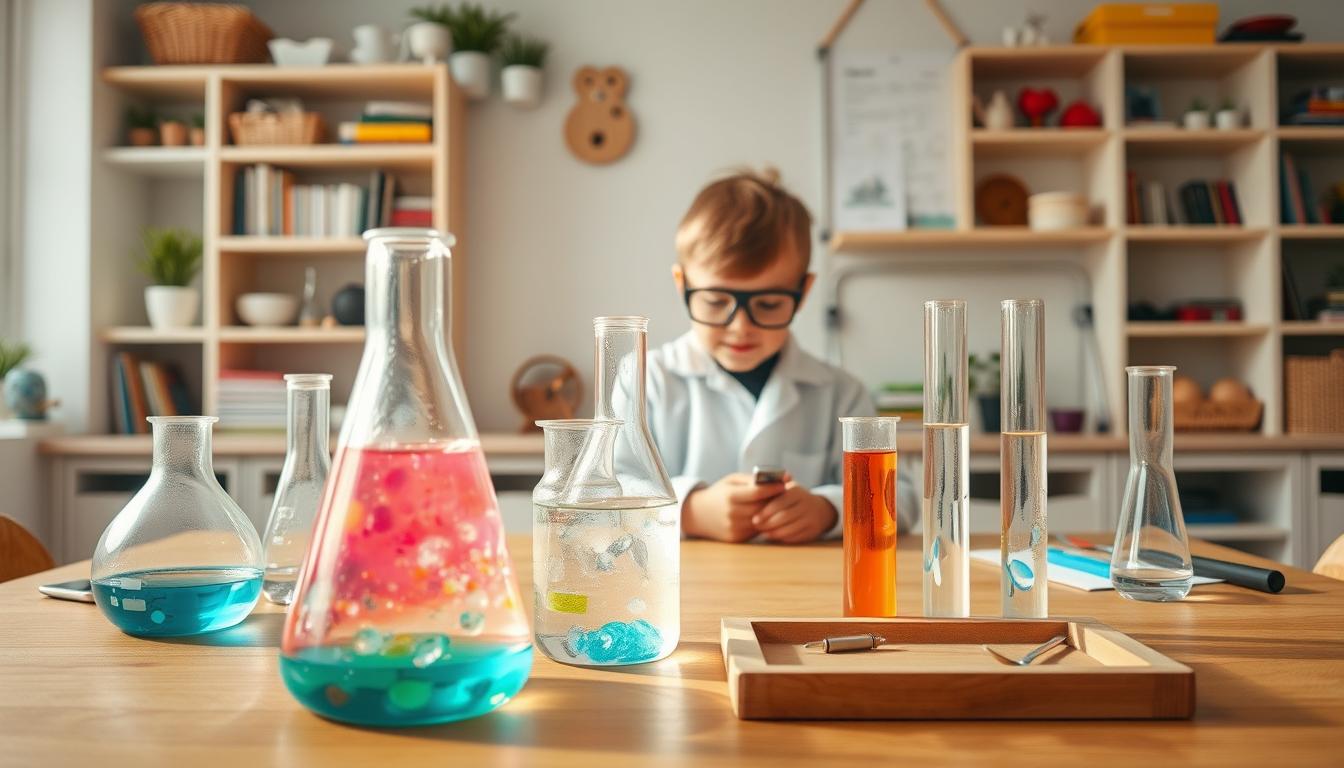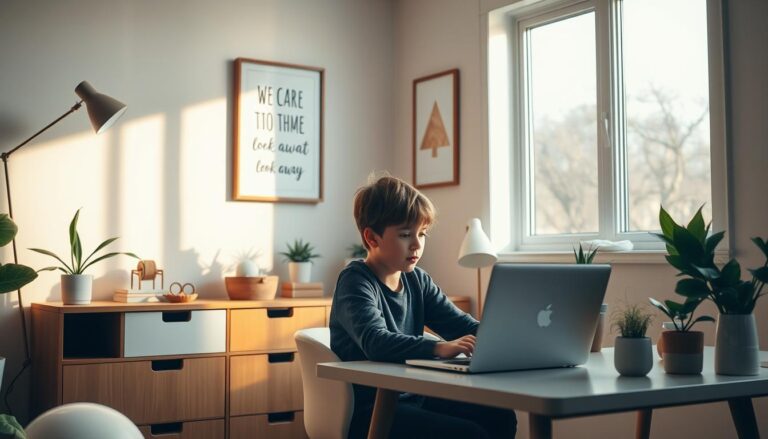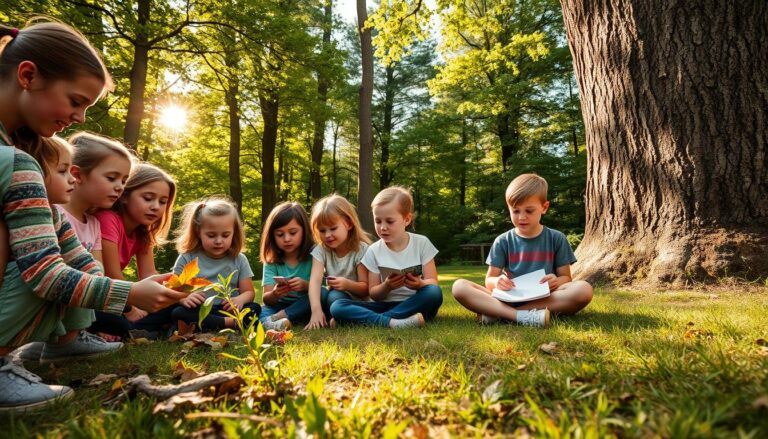Science Experiments for Home Pre-School Learning
Have you ever wondered how simple household items can transform into tools for discovery? At home, we can create moments of wonder that ignite a lifelong love for learning in young minds. With just a few everyday materials, we can turn curiosity into meaningful exploration.
These hands-on experiments are designed to be safe, engaging, and easy to set up. From colorful reactions to simple physics, each activity encourages creativity and critical thinking. We’ve carefully curated these ideas to blend fun with foundational concepts, making learning an exciting adventure.
Whether it’s a float or sink test or a creative STEM challenge, these experiments are perfect for young learners. They not only teach basic principles but also help develop essential skills like observation and problem-solving. Let’s dive into a world of discovery together!
Introduction: Sparking Curiosity at Home
Curiosity is the spark that ignites a child’s journey into the world of discovery. At home, we can nurture this natural instinct by creating environments that encourage exploration and learning. Simple, hands-on science experiments using everyday items can transform ordinary moments into extraordinary lessons.
Water, for example, is a versatile tool for engaging young minds. Activities like observing water absorption or creating a cloud in a jar provide dramatic, visual reactions that captivate children. These experiences not only teach basic concepts but also inspire a sense of wonder and excitement.
Engaging Our Little Scientists
Our goal is to make learning fun and interactive. By blending play with education, we help children develop critical thinking and problem-solving skills. Open-ended activities encourage them to ask questions, explore possibilities, and discover answers on their own.
This guide is designed to help parents and educators choose experiments that provoke thoughtful questions and spark new interests. Together, we can turn everyday moments into opportunities for discovery and growth.
Unlocking the World of Preschool Science Activities
Turn your kitchen into a lab with colorful and engaging experiments. We’ve curated a range of activities that use everyday items to create magical moments of discovery. These experiments are designed to be simple, impactful, and perfect for young learners.
One of the most captivating activities is the Magic Dancing Milk experiment. By adding drops of food coloring to milk and introducing a bit of dish soap, children can watch as vibrant colors swirl and dance. This activity not only introduces the concept of surface tension but also sparks curiosity about how everyday materials interact.
Vinegar-based experiments are another exciting way to explore science at home. Combining vinegar with baking soda creates a fizzy reaction that delights children while teaching them about chemical reactions. These activities are not only fun but also lay the foundation for understanding basic scientific principles.
Exploring color changes and reactions can make learning feel like magic. Whether it’s mixing colors in water or observing how vinegar transforms milk, these experiments are designed to be both accessible and educational. They encourage children to ask questions, make predictions, and discover answers on their own.
We believe that every child has the potential to be a little scientist. By providing these hands-on experiences, we help unlock a world of curiosity and learning. Together, let’s inspire the next generation of thinkers and explorers.
Simple Experiments with Everyday Items
Discover how everyday objects can spark curiosity and learning in young minds. With just a few household items, we can create engaging activities that teach valuable lessons. These experiments are not only affordable but also interactive, making them perfect for every kid.
Float or Sink Adventures
This classic activity is a fantastic way to introduce the concept of buoyancy. Gather items like a spoon, toy, or leaf, and ask your preschooler to predict whether each will float or sink. Watching their reactions as they test their predictions is both fun and educational.
This experiment encourages critical thinking and observation skills. It’s a simple yet effective way to explore scientific principles using items you already have at home.
Magic Dancing Milk
Another exciting activity is the Magic Dancing Milk experiment. Pour milk into a shallow dish, add drops of food coloring, and introduce a bit of dish soap. Watch as the colors swirl and dance, creating a mesmerizing display.
This experiment teaches kids about surface tension and chemical reactions in a visually engaging way. It’s a perfect example of how everyday materials can turn into tools for discovery.
These activities are designed to be fun and educational, fostering a love for learning in every preschooler. For more ideas, check out these engaging science experiments that use simple materials to create big moments of wonder.
Exploring Chemical Reactions in the Home Kitchen
The kitchen isn’t just for cooking—it’s a space where chemistry comes to life. With common ingredients like baking soda, vinegar, and food coloring, we can create dynamic experiments that captivate young minds. These activities turn everyday moments into opportunities for discovery and learning.
By using simple materials, we can demonstrate fascinating chemical reactions. These experiments are not only fun but also educational, helping children understand basic scientific principles. Let’s dive into two exciting activities that bring chemistry to your home kitchen.
Baking Soda and Vinegar Volcanoes
This classic experiment is a favorite for a reason. Mix baking soda and vinegar in a 1:1 ratio to create a fizzy eruption. Add a few drops of food coloring for extra visual appeal. Watch as the reaction unfolds, teaching kids about acids, bases, and gas formation.
This activity is perfect for encouraging hands-on play. It’s a great way to introduce the concept of chemical reactions in a safe and engaging manner. Plus, it’s easy to set up with items you already have at home.
Rainbow Eruption Creations
Take the experiment to the next level with Rainbow Eruption Creations. Use paper cups to hold different colors of vinegar. Add baking soda to each cup and watch as vibrant eruptions burst forth. This activity combines creativity with science, making it a hit with young learners.
Timing is key to getting the most out of this experiment. Encourage kids to observe how the colors mix and interact. It’s a fantastic way to explore both chemistry and art in one fun activity.
These experiments are part of our preschool e-learning program, designed to make learning interactive and enjoyable. By turning your kitchen into a lab, you can spark curiosity and inspire a love for discovery in every child.
Hands-On STEM Challenges for Young Learners
Simple materials like paper and jars can unlock a world of exploration for young minds. These hands-on STEM challenges are designed to spark curiosity and creativity while teaching fundamental concepts. Using everyday items, we can create engaging projects that encourage problem-solving and critical thinking.
Each activity is crafted to be interactive and fun, making learning an adventure. From building a robot hand to engineering a bubble machine, these challenges provide tactile experiences that inspire young learners to explore and discover.
DIY Robot Hand Construction
One exciting project is the DIY Robot Hand. Using paper, straws, and string, kids can build a simple robotic device. This activity teaches basic engineering principles while encouraging creativity. As they assemble the hand, children learn about movement and mechanics in a hands-on way.
This project is perfect for fostering curiosity and exploration. It’s a great way to introduce young learners to the world of robotics and engineering.
Bubble Machine Engineering
Another engaging challenge is the Bubble Machine Engineering project. By manipulating air pressure in a jar, kids can create a bubble-making machine. This activity combines creativity with scientific exploration, teaching concepts like air flow and pressure.
Children will love watching their creations come to life as bubbles fill the air. It’s a fun and educational way to explore STEM concepts while encouraging hands-on learning.
These challenges are designed to build foundational skills in an enjoyable and interactive manner. By tackling real-world problems, young learners develop critical thinking and a love for discovery.
Learning About Plants Through Science
Exploring the natural world can be as simple as planting a seed and watching it grow. Plants offer a hands-on way to teach young minds about life cycles, change, and responsibility. With just a few everyday materials, we can create engaging experiments that bring nature indoors.
One of the most effective ways to introduce plant science is through the Growing Beans on Cotton Balls experiment. This activity uses water (liquid) to foster germination and growth, allowing children to observe the process over several days. It’s a simple yet powerful way to connect with nature and understand its wonders.
Growing Beans on Cotton Balls
This experiment is easy to set up and requires minimal materials. Here’s how it works:
| Step | Description |
|---|---|
| 1 | Place a few cotton balls in a clear container. |
| 2 | Add a bean seed on top of the cotton balls. |
| 3 | Moisten the cotton with water (liquid) until damp but not soaked. |
| 4 | Place the container in a sunny spot and observe daily. |
| 5 | Record changes over several days, noting root and sprout formation. |
Daily observation is key to this experiment. Children can track the seed’s progress, noting how it absorbs water and begins to sprout. This process helps them understand the stages of plant life, from germination to growth.
Variations in liquid absorption and environmental conditions can produce a “rainbow” of growth patterns. For example, using different amounts of water or placing the container in varying light conditions can lead to unique results. These variations encourage critical thinking and curiosity.
Learning about plants from a scientific perspective fosters observation skills and a sense of responsibility. By caring for their growing seeds, children develop a deeper appreciation for nature and its processes. This experiment is a perfect way to blend education with hands-on discovery.
Investigating Water and Liquid Dynamics
Water is a fascinating element that shapes our world in countless ways. From its ability to sustain life to its unique physical properties, water offers endless opportunities for exploration. In this section, we dive into two engaging experiments that reveal the wonders of liquid dynamics.
Create a Cloud in a Jar
This experiment brings the magic of weather into your home. By combining warm water, ice, and a bit of hairspray, we can simulate how clouds form in the atmosphere. Here’s how it works:
- Fill a jar with hot water and swirl it around to warm the glass.
- Place a lid filled with ice on top of the jar.
- Spray a small amount of hairspray into the jar and watch as a cloud forms.
This activity demonstrates how water vapor condenses into visible droplets, creating a cloud. It’s a simple yet powerful way to connect everyday life with natural phenomena.
Understanding Water Density
Why do some objects float while others sink? This experiment explores the concept of density using water and everyday items. Here’s what you’ll need:
- A clear container filled with water.
- Objects like a cork, coin, and plastic toy.
Ask your child to predict which items will float and which will sink. As they test their predictions, they’ll learn how density determines whether an object stays afloat or sinks. This hands-on activity encourages critical thinking and observation skills.
These experiments highlight the role of water in our lives and its fascinating properties. By exploring liquid dynamics, we help young learners develop a deeper understanding of the world around them. Let’s continue to inspire curiosity and discovery through these simple yet impactful activities.
Creative Experiments Merging Art and Science
Art and science may seem like opposites, but together they create unforgettable learning moments. By blending creativity with discovery, we can inspire young minds to explore the world in new ways. These experiments are designed to be visually engaging while teaching fundamental concepts.
One of the most captivating activities is the Shaving Cream Clouds experiment. This project demonstrates the density differences between liquids while creating a visually magical effect. By layering shaving cream and colored water, children can observe how liquids interact and form stunning patterns.
Shaving Cream Clouds for Visual Magic
This experiment mimics atmospheric changes, like the formation of rain, in a controlled environment. Here’s how it works:
- Fill a clear container with water, leaving space at the top.
- Add a layer of shaving cream to represent a cloud.
- Drop food coloring onto the shaving cream and watch as it “rains” into the water below.
The activity highlights chemical reactions and density in a way that’s easy to understand. It’s perfect for young learners, making complex concepts approachable through art. By combining creativity with scientific inquiry, we can ignite curiosity and inspire a love for discovery.
These experiments are designed to be accessible and engaging for children of all ages. They encourage hands-on learning, critical thinking, and a deeper appreciation for the world around us. Let’s continue to explore the magic of art and science together!
Fun with Magnets and Air Pressure
Magnets and air pressure hold the power to turn everyday moments into fascinating discoveries. These invisible forces are all around us, and with a few simple tools, we can explore their magic. Through hands-on experiments, we can help young learners understand these concepts in a fun and engaging way.
These activities are designed to spark curiosity and encourage creative thinking. By using ordinary magnets and household items, we can demonstrate how forces like magnetism and air pressure work. Each experiment offers a unique opportunity to observe and learn.
Exploring DIY Magnetic Discoveries
One of the most exciting ways to explore magnetism is through DIY Magnetic Discoveries. Using simple magnets, children can test which objects are attracted or repelled. This activity introduces the concept of magnetic fields and encourages critical thinking.
For example, try creating a magnet maze using LEGO pieces or a piece of cardboard. Place a small object, like a paperclip, on the maze and use a magnet underneath to guide it. This experiment shows how magnets can exert force without direct contact.
Another fun idea is to make a magnet fishing rod. Attach a magnet to a string and use it to “fish” for metal objects in a bowl of water. This activity not only teaches magnetism but also enhances fine motor skills.
These experiments highlight the variety of ways magnets can be used to explore scientific principles. By changing the strength of the magnet or the materials used, children can observe different outcomes. This hands-on approach builds a strong foundation in STEM learning.
Through these activities, we can inspire a love for discovery and help young minds understand the world around them. Let’s dive into the wonders of magnets and air pressure together!
Sensory Science: Engaging Every Sense
Engaging multiple senses can transform learning into an unforgettable experience. Sensory activities captivate young minds by combining touch, sound, and sight. These experiments are designed to help every child learn and develop new skills in a playful and meaningful way.
Color-Changing Chemical Reactions
One of the most visually stunning experiments is the Color-Changing Chemical Reaction. Using simple ingredients like cabbage juice and vinegar, children can observe vibrant color changes. This activity introduces basic chemistry while stimulating curiosity and creativity.
Here’s how to set it up:
- Boil red cabbage to extract its juice.
- Pour the juice into clear containers.
- Add vinegar or baking soda to observe color shifts.
This experiment not only teaches chemical reactions but also encourages observation and critical thinking.
Water Xylophone Musical Experiments
Another engaging activity is the Water Xylophone. By filling glasses with varying amounts of water, children can create different sound pitches. This experiment combines auditory learning with basic physics concepts.
Steps to try it at home:
- Arrange glasses in a row and fill them with different water levels.
- Use a spoon to tap each glass and listen to the sounds.
- Discuss how water levels affect pitch and volume.
This activity helps develop auditory skills while making learning fun and interactive.
By engaging every sense, we create comprehensive and memorable learning experiences. These activities inspire curiosity, creativity, and a love for discovery in every child.
Integrating Science into Daily Play and Routines
Simple routines like hand-washing can teach big lessons about the world around us. By blending play with everyday tasks, we can make learning both fun and meaningful. These activities not only reinforce key concepts but also encourage children to observe and explore their surroundings.
Soap and Glitter: Understanding Germs
One engaging way to introduce science into daily life is through the Soap and Glitter experiment. This activity uses glitter as a proxy for germs, showing how soap disperses and removes them. Here’s how it works:
- Sprinkle glitter onto a child’s hands to represent germs.
- Add a drop of soap and ask them to rub their hands together.
- Watch as the glitter is washed away, demonstrating how soap works.
This experiment is a great way to teach hygiene while exploring the concept of surface tension and chemical interactions.
Familiar items like food and baking soda can also serve as tools for discovery. For example, mixing baking soda with vinegar creates a fizzy reaction that introduces the concept of chemical changes. These activities make learning a natural part of daily life.
By integrating science into routines, we help children develop observational skills and a deeper understanding of the world. These experiments show that learning doesn’t have to be confined to a classroom—it can happen anywhere, anytime.
Tips for Supervised Home Science Learning
Creating a safe and engaging environment for home learning is essential for fostering curiosity. With the right guidance, we can turn everyday moments into opportunities for discovery. Supervision and preparation are key to making experiments both fun and secure.
We believe that every child deserves a safe space to explore the world around them. By following a few simple tips, we can ensure that home experiments are both educational and risk-free. Let’s dive into some strategies for supervised learning.
Ensuring Safety with Simple Setups
Safety is the foundation of any successful experiment. We recommend starting with simple setups that are easy to manage. This not only reduces risks but also allows children to focus on the learning process.
Here are some essential tips for safe and effective home experiments:
| Tip | Description |
|---|---|
| Supervision | Always supervise children during experiments to ensure safety and provide guidance. |
| Clear Instructions | Provide step-by-step instructions to help children understand each step of the process. |
| Child-Safe Materials | Use non-toxic and age-appropriate materials to minimize risks. |
| Adjust for Skill Levels | Tailor experiments to match the child’s curiosity and skill level for a more engaging experience. |
| Safety Protocols | Establish basic safety rules, such as washing hands and avoiding ingestion of materials. |
These ideas ensure that every experiment is both enjoyable and secure. By adjusting setups to suit different skill levels, we can create a world of learning opportunities for every child.
Supervision doesn’t mean limiting creativity. Instead, it provides a framework for safe exploration. With clear instructions and safety protocols, we can inspire curiosity while minimizing risks.
We encourage parents and educators to embrace these tips for a seamless learning experience. By combining safety with creativity, we can unlock a world of discovery for young minds.
Conclusion
Learning through hands-on exploration can make every day an adventure. These home-based experiments are designed to spark curiosity and foster a love for discovery. They provide rich learning experiences that are both educational and fun, making them accessible to children at every level.
We’ve highlighted how simple materials can turn into powerful tools for learning. From colorful reactions to creative challenges, these activities encourage critical thinking and problem-solving. They are easy to adapt, allowing parents and educators to tailor them to a child’s interests and skill level.
By integrating these experiments into daily routines, we can make learning a natural part of life. They not only teach foundational concepts but also inspire lifelong curiosity. We invite you to explore these ideas further and continue finding new ways to make every moment a chance to learn and grow.







